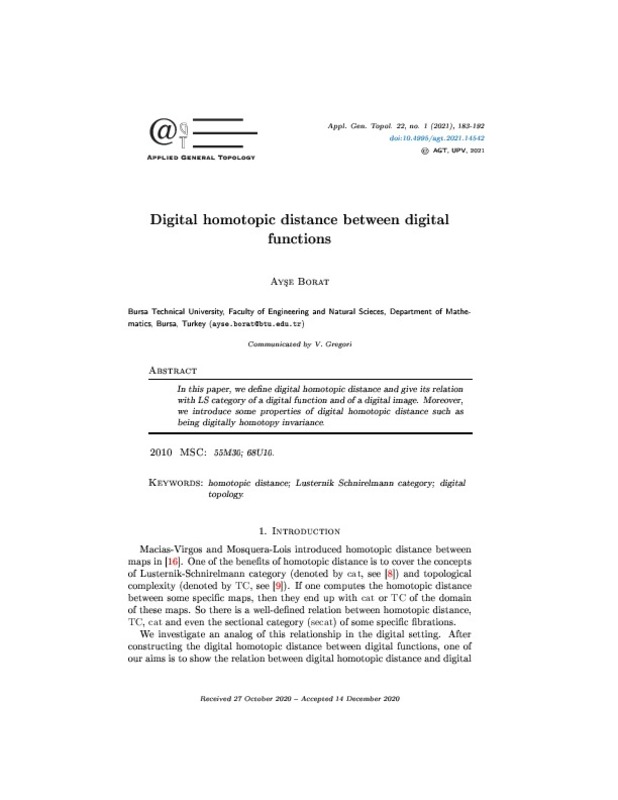JavaScript is disabled for your browser. Some features of this site may not work without it.
Buscar en RiuNet
Listar
Mi cuenta
Estadísticas
Ayuda RiuNet
Admin. UPV
Digital homotopic distance between digital functions
Mostrar el registro sencillo del ítem
Ficheros en el ítem
| dc.contributor.author | Borat, Ayse
|
es_ES |
| dc.date.accessioned | 2021-04-16T09:14:40Z | |
| dc.date.available | 2021-04-16T09:14:40Z | |
| dc.date.issued | 2021-04-01 | |
| dc.identifier.issn | 1576-9402 | |
| dc.identifier.uri | http://hdl.handle.net/10251/165251 | |
| dc.description.abstract | [EN] In this paper, we define digital homotopic distance and give its relation with LS category of a digital function and of a digital image. Moreover, we introduce some properties of digital homotopic distance such as being digitally homotopy invariance. | es_ES |
| dc.description.sponsorship | The author would like to thank Tane Vergili and the referees for their helpful suggestions. In particular, the author would like to thank the referee who contributed Proposition 3.2 and Example 4.3. | es_ES |
| dc.language | Inglés | es_ES |
| dc.publisher | Universitat Politècnica de València | es_ES |
| dc.relation.ispartof | Applied General Topology | es_ES |
| dc.rights | Reconocimiento - No comercial - Sin obra derivada (by-nc-nd) | es_ES |
| dc.subject | Homotopic distance | es_ES |
| dc.subject | Lusternik Schnirelmann category | es_ES |
| dc.subject | Digital topology | es_ES |
| dc.title | Digital homotopic distance between digital functions | es_ES |
| dc.type | Artículo | es_ES |
| dc.identifier.doi | 10.4995/agt.2021.14542 | |
| dc.rights.accessRights | Abierto | es_ES |
| dc.description.bibliographicCitation | Borat, A. (2021). Digital homotopic distance between digital functions. Applied General Topology. 22(1):183-192. https://doi.org/10.4995/agt.2021.14542 | es_ES |
| dc.description.accrualMethod | OJS | es_ES |
| dc.relation.publisherversion | https://doi.org/10.4995/agt.2021.14542 | es_ES |
| dc.description.upvformatpinicio | 183 | es_ES |
| dc.description.upvformatpfin | 192 | es_ES |
| dc.type.version | info:eu-repo/semantics/publishedVersion | es_ES |
| dc.description.volume | 22 | es_ES |
| dc.description.issue | 1 | es_ES |
| dc.identifier.eissn | 1989-4147 | |
| dc.relation.pasarela | OJS\14542 | es_ES |
| dc.description.references | C. Berge, Graphs and Hypergraphs, 2nd edition, North-Holland, Amsterdam, 1976. | es_ES |
| dc.description.references | A. Borat and T. Vergili, Digital Lusternik-Schnirelmann category, Turkish Journal of Mathematics 42, no 1 (2018), 1845-1852. https://doi.org/10.3906/mat-1801-94 | es_ES |
| dc.description.references | A. Borat and T. Vergili, Higher homotopic distance, Topological Methods in Nonlinear Analysis, to appear. | es_ES |
| dc.description.references | L. Boxer, Digitally continuous functions, Pattern Recognit. Lett. 15 (1994), 883-839. https://doi.org/10.1016/0167-8655(94)90012-4 | es_ES |
| dc.description.references | L. Boxer, A classical construction for the digital fundamental group, Journal of Mathematical Imaging and Vision 10 (1999), 51-62. https://doi.org/10.1023/A:1008370600456 | es_ES |
| dc.description.references | L. Boxer, Homotopy properties of sphere-like digital images, J. Math. Imaging Vision, 24 (2006), 167-175. https://doi.org/10.1007/s10851-005-3619-x | es_ES |
| dc.description.references | L. Boxer, Alternate product adjacencies in digital topology, Applied General Topology 19, no. 1 (2018), 21-53. https://doi.org/10.4995/agt.2018.7146 | es_ES |
| dc.description.references | O. Cornea, G. Lupton, J. Oprea and D. Tanre, Lusternik-Schnirelmann Category, Mathematical Surveys and Monographs, vol. 103, American Mathematical Society 2003. https://doi.org/10.1090/surv/103 | es_ES |
| dc.description.references | M. Farber, Topological complexity of motion planning, Discrete and Computational Geometry 29 (2003), 211-221. https://doi.org/10.1007/s00454-002-0760-9 | es_ES |
| dc.description.references | S. E. Han, Non-product property of the digital fundamental group, Information Sciences 171 (2005), 73-91. https://doi.org/10.1016/j.ins.2004.03.018 | es_ES |
| dc.description.references | M. Is and I. Karaca, The higher topological complexity in digital images, Applied General Topology 21, no. 2 (2020), 305-325. https://doi.org/10.4995/agt.2020.13553 | es_ES |
| dc.description.references | I. Karaca and M. Is, Digital topological complexity numbers, Turkish Journal of Mathematics 42, no. 6 (2018), 3173-3181. https://doi.org/10.3906/mat-1807-101 | es_ES |
| dc.description.references | E. Khalimsky, Motion, deformation, and homotopy in finite spaces, Proceedings IEEE International Conference on Systems, Man, and Cybernetics (1987), 227-234. | es_ES |
| dc.description.references | G. Lupton, J. Oprea and N. A. Scoville, Homotopy theory in digital topology, ArXiv: 1905.07783. | es_ES |
| dc.description.references | G. Lupton, J. Oprea and N. A. Scoville, Subdivisions of maps of digital images, ArXiv: 1906.03170. | es_ES |
| dc.description.references | E. Macias-Virgos and D. Mosquera-Lois, Homotopic distance between maps, Math. Proc. Cambridge Philos. Soc., to appear. | es_ES |
| dc.description.references | G. Sabidussi, Graph multiplication, Math. Z. 72 (1960), 446-457. https://doi.org/10.1007/BF01162967 | es_ES |
| dc.description.references | T. Vergili and A. Borat, Digital Lusternik-Schnirelmann category of digital functions, Hacettepe Journal of Mathematics and Statistics 49, no. 4 (2020), 1414-1422. https://doi.org/10.15672/hujms.559796 | es_ES |








